Moniek Bloks's Blog, page 166
October 1, 2020
Taking a look at Crown Princess Mary of Denmark
The future Crown Princess of Denmark was born Mary Elizabeth Donaldson on 5 February 1972 in Hobart, Tasmania, Australia as the youngest daughter of John Dalgleish Donaldson and his first wife, Henrietta Clark Horne. She has two sisters, Jane Stephens and Patricia Bailey and a brother John Stuart Donaldson. Mary’s mother died on 20 November 1997, and her father remarried to Susan Elizabeth Horwood in 2001.
Mary spent two years of her early education at Clear Lake City Elementary School in Houston, Texas, where her father was working at the time. Upon the family’s return to Australia in 1975, she attended the Sandy Bay Infants School until 1977. After that, she attended the Waimea Heights Primary School until 1982. She attended the Taroona High School from 1983 until 1986, and she also spent two years at the Hobart Matriculation College, where she developed a love for sports. She enrolled in the University of Tasmania in 1989 and graduated with a Bachelor’s degree in Commerce and Law in 1994.
She began her career with the advertising agency DDB Needham in their graduate program and became an account executive for client management. Over the years, she worked at MOJO Partners, Rapp Collins Worldwide of Edinburgh, Young and Rubicam, Love and Belle Property.
Embed from Getty Images
Mary met her future husband, Frederik, Crown Prince of Denmark, on 16 September 2000 during the 2000 Summer Olympics. He travelled back and forth between Denmark, and they conducted a long-distance relationship. Mary briefly worked in Paris before making the final move to Denmark. On 24 September 2003, it was announced that Frederik’s mother Queen Margrethe II of Denmark intended to give her consent to their marriage. They were officially engaged on 8 October 2003.
Embed from Getty Images
On 14 May 2004, Mary and Frederik married in Copenhagen Cathedral. Mary wore a wedding dress designed by Uffe Frank, a Danish designer. Her bridal party included her two sisters and her friend Amber. Mary’s veil had a rich royal history and was first worn by Princess Margaret of Connaught, later Crown Princess of Sweden. Her daughter Ingrid became Queen of Denmark and was the mother of Queen Margrethe II. Both wore the veil as well. Mary’s wedding tiara was a gift from Queen Margrethe and her husband, Prince Henrik. Mary also converted from Presbyterianism to the Lutheran Church of Denmark. Upon marriage, she became Her Royal Highness Crown Princess Mary Elizabeth of Denmark. She was also granted the Danish nationality.
After the wedding, the newlyweds spent the summer on a working-tour of Denmark, before travelling to Greenland and attending the 2004 Olympics in Athens. Their first child, Prince Christian, was born the following year on 15 October. He was followed by Princess Isabella on 21 April 2007 and twins Prince Vincent and Princess Josephine on 8 January 2011.
Embed from Getty Images
Embed from Getty Images
Embed from Getty Images
As Crown Princess of Denmark, Mary has picked up a number of royal patronages and she learned to speak Danish fluently. In 2019, she became the first person not born into the Danish royal family since 1972 to be appointed rigsforstander (regent). If she becomes Queen consort as expected, she’ll be the first Australian-born Queen consort in a reigning European dynasty.1
The post Taking a look at Crown Princess Mary of Denmark appeared first on History of Royal Women.
Belgium gains a new Princess
Her new official name will Delphine of Saxe-Coburg (van Saksen-Coburg). Her children Josephine (16) and Oscar (12) will also be recognised as Princess and Prince with the style of Their Royal Highness. There has been no word on an official allowance for Princess Delphine.
Delphine has been fighting to be recognised as the daughter of King Albert II, who abdicated in favour of his son King Philippe in 2013, for many years. The case came to a head in 2019 when the former King was finally forced to undergo a DNA-test under threat of a 5,000 euro a day penalty for refusing to take the DNA-test.
Delphine was born in 1968 as the daughter of Baroness Sybille de Selys Longchamps and was officially recognised by her mother’s husband Jonkheer Jacques Boël (of which the English equivalent would be Esquire). The King made a reference to a crisis ‘thirty years ago’ in the 1999 Christmas speech but has otherwise remained silent on the subject. Delphine Boël has always claimed that it was not about any inheritance, as her legal father is much richer than the King.
In 2013, Delphine summoned King Albert and two of his children, the Duke of Brabant, now King Philippe and Princess Astrid of Belgium, Archduchess of Austria-Este to court in hopes of obtaining DNA for testing purposes. The King enjoyed immunity at the time, but his abdication in July 2013 opened the way for a new procedure. The former King of the Belgians was part of a great deal of Delphine’s childhood but has wanted nothing to do with her for the past 20 years. He has also refused to appear in court.
The post Belgium gains a new Princess appeared first on History of Royal Women.
September 29, 2020
The Oldenburg Mausoleum at the Gertrudenfriedhof
The Oldenburg Mausoleum at the Gertrudenfriedhof was constructed from 1785 upon the death in childbirth of 20-year-old Frederica of Württemberg, the wife of the future Peter I, Grand Duke of Oldenburg. She was the first to be buried there upon completion in 1790. The mausoleum was built on the edge of the cemetery grounds and towers over it.
Burials of the Oldenburg rulers continued over the following years and the following women are buried there:
1. Adelheid of Anhalt-Bernburg-Schaumburg-Hoym
2. Ida of Anhalt-Bernburg-Schaumburg-Hoym
3. Cecilie of Sweden
4. Amalia of Sweden
5. Elisabeth Anna of Prussia
6. Elisabeth of Saxe-Altenburg
7. Rixa of Oldenburg
8. Elisabeth Alexandrine of Mecklenburg-Schwerin
9. Donata of Castell-Rüdenhausen
10. Ameli of Löwenstein-Wertheim-Freudenberg
11. Frederica of Württemberg
The mausoleum is generally not open to the public but the public was given a look inside after renovations in 2013.
Click to view slideshow.
The post The Oldenburg Mausoleum at the Gertrudenfriedhof appeared first on History of Royal Women.
Stripping titles – The case of the Duke and Duchess of Sussex
There have been a lot of recent comments about whether or not The Duke and Duchess of Sussex should be stripped of their titles. Without getting into whether I agree with this or not, can it even be done?
There are two separate things to look at; the peerage and the HRH. By birth, Harry is His Royal Highness Prince Henry (Harry) of Wales. Upon his wedding day, he was granted the Dukedom of Sussex, in the Peerage of the United Kingdom, with the subsidiary titles of Earl of Dumbarton and Baron Kilkeel. Upon marriage, Meghan began to share his status and rank becoming The Duchess of Sussex with the status of a Princess. She does not carry a title in her own right, and if any titles are removed, they must be removed from Prince Harry.
Firstly, a peerage, in this case, The Dukedom of Sussex and its subsidiary titles, cannot be removed unless by Act of Parliament. This has only ever been done once before. The Titles Deprivation Act 19171 was used to remove the peerages of enemies of the United Kingdom during the First World War. This included three male-line British Princes and a Viscount.
His Royal Highness Charles Edward, Duke of Albany, Earl of Clarence and Baron Arklow – Grandson of Queen Victoria and the last Duke of Saxe-Coburg and Gotha.
His Royal Highness Ernest Augustus, Duke of Cumberland and Teviotdale, Earl of Armagh – Great-grandson of King George III and Crown Prince of Hanover.
His Royal Highness Ernest Augustus – Son of the above.
Henry, Viscount Taaffe of Corren and Baron of Ballymote – Bore arms against the United Kingdom.
These four people were deprived of their peerages by the King’s Order in Council of 28 March 1919, as authorised by the Titles Deprivation Act 1917. The first three retained their (distant) succession rights to the throne, and they also retained their titles of Prince of the United Kingdom of Great Britain and Ireland. So keep in mind, if a new Act of Parliament is done, this will only affect the peerage. If the Dukedom is removed, Meghan and Harry will still be known as Their Royal Highnesses Prince and Princess Henry of Wales. Also considering the only other time this method has been used – for enemies of the United Kingdom – I’d find it highly unlikely it will be done.
Secondly, the styling of HRH was discussed, and it was announced that the Duke and Duchess would not use the style of HRH in business, but they still retain the style. This is due to the 1917 Letters Patent which limits the title of Prince or Princess to the children of the sovereign, the grandchildren of the sovereign in the male line, and the eldest son of the eldest son of the Prince of Wales. In 2012, this was expanded to include all the children of the eldest son of the Prince of Wales ensuring that both Princess Charlotte and Prince Louis were born Prince and Princess.
In 1919, Princess Patricia of Connaught asked if she could relinquish “the style of Royal Highness and the title of Princess of Great Britain and Ireland” upon marriage, which was permitted by King George V by Letters Patent.2 This was done voluntarily and she became known as Lady Patricia Ramsay. Nevertheless, at the following two coronations, she wore the coronet and robes of a Princess, showing that she had not been stripped of the style and title. I don’t see this option happening for the Duke and Duchess of Sussex either. Would they then be known as Their Graces The Duke and Duchess of Sussex?
Perhaps the easiest way out of the mob’s call for their heads would be for them to go by Harry and Meghan Sussex in business. This would be similar to how Princess Eugenie is known as Eugenie York at work and how her uncle was known as Edward Windsor when he was not a full-time royal.
Read also:
Lady Louise Windsor is a Princess – Here’s why
Denying HRH – The Case of the Duchess of Windsor
The Duchess of Cornwall is a Princess, and she will be Queen – Here’s why
The Duchess of Cambridge will become Duchess of Cornwall – Here’s why
The curtsey myth and a protocol made for breaking
The post Stripping titles – The case of the Duke and Duchess of Sussex appeared first on History of Royal Women.
September 27, 2020
Queen Elizabeth I – The body of a weak and feeble woman (Part four)
The trouble with Mary, Queen of Scots, was not over yet. The Babington Plot of 1586 saw Elizabeth’s spymaster Sir Francis Walsingham beginning to assemble a case against her. Following a letter in which Mary incriminated herself1 in the plot, she was put on trial. However, putting a sister sovereign to death would be difficult for Elizabeth. She tried to find ways to avoid executing Mary while securing her own safety, saying that she had, “just cause to complain that, who have in my time pardoned so many rebels, winked at so many reasons, and either not produced them or altogether slipped them over with silence, should now be forced to this proceeding, against such a person.”2 On 1 February 1587, Elizabeth finally signed Mary’s death warrant, and it was dispatched quickly to avoid a change of heart. Mary, Queen of Scots, was executed at Fotheringhay on 8 February. Elizabeth became enraged that Mary had been put to death and even sent Mary’s son a letter to explain that she had been executed contrary to her wishes. The sincerity of this letter is under debate.
In any case, a significant threat to Elizabeth’s throne had been removed, but Elizabeth said, “This death will wring her heart as long as she lives.”3 Just a year later, Elizabeth would face the Spanish Armada, sent by King Philip II of Spain in order to invade England and to overthrow Elizabeth. She held her famous Tilbury speech, not knowing that the threat of invasion had already passed after the Armada had been driven from the Strait of Dover in the Battle of Gravelines. Several versions of the speech exist, and this is one of them:
My loving people.
We have been persuaded by some that are careful of our safety, to take heed how we commit our selves to armed multitudes, for fear of treachery; but I assure you I do not desire to live to distrust my faithful and loving people. Let tyrants fear. I have always so behaved myself that, under God, I have placed my chiefest strength and safeguard in the loyal hearts and good-will of my subjects; and therefore I am come amongst you, as you see, at this time, not for my recreation and disport, but being resolved, in the midst and heat of the battle, to live and die amongst you all; to lay down for my God, and for my kingdom, and my people, my honour and my blood, even in the dust.
I know I have the body of a weak, feeble woman; but I have the heart and stomach of a king, and of a king of England too, and think foul scorn that Parma or Spain, or any prince of Europe, should dare to invade the borders of my realm; to which rather than any dishonour shall grow by me, I myself will take up arms, I myself will be your general, judge, and rewarder of every one of your virtues in the field.
I know already, for your forwardness you have deserved rewards and crowns; and We do assure you on a word of a prince, they shall be duly paid. In the mean time, my lieutenant general shall be in my stead, than whom never prince commanded a more noble or worthy subject; not doubting but by your obedience to my general, by your concord in the camp, and your valour in the field, we shall shortly have a famous victory over these enemies of my God, of my kingdom, and of my people.4
Her reign after the Armada was marred by the conflict with Spain and a new generation of councillors came on board as the others died. Her own image remained important to her, and paintings from that time became less realistic as she aged. As she grew older, her temper became progressively shorter, and she became more melancholic. One courtier recalled, “Towards her last, she grew somewhat hard to please.”5 Elizabeth still exercised regularly to keep fit and agile. Elizabeth never did publicly acknowledge who her successor would be but among her subjects most believed that it would be the King of Scots, Mary’s son.
At the end of February 1603, the Countess of Nottingham – a granddaughter of Mary Boleyn and thus a cousin of Elizabeth, died, plunging Elizabeth into a depression. She began to suffer from various aches – insomnia, lack of appetite and incessant thirst. She had lost the will to live and spent her days on the floor on cushions. By 22 March, she was finally coaxed to her bed and lost her speech the following day. She died between two and three in the morning on 24 March 1603. At ten in the morning, King James VI of Scotland was also proclaimed King of England, Ireland and France. Elizabeth lay in state at Whitehall before being given an elaborate funeral on 28 April. She now rests in a shared tomb with her half-sister Queen Mary I, though only Elizabeth is depicted.
Embed from Getty Images
Pope Sixtus V once said, “She is only a woman, only mistress of half an island, and yet she makes herself feared by Spain, by France, by the Empire, by all.”6
The post Queen Elizabeth I – The body of a weak and feeble woman (Part four) appeared first on History of Royal Women.
September 26, 2020
Taking a look at Queen Máxima of the Netherlands
Máxima Zorreguieta Cerruti was born on 17 May 1971 in Buenos Aires, Argentina, to Jorge Horacio Zorreguieta (a government official and advisor) and María del Carmen Cerruti de Zorreguieta. The Queen’s maiden last names follow Spanish naming customs where the child takes their father’s last name (Zorreguieta) and their mother’s last name (Cerruti). In most instances, the children go by their ‘first’ last name in school and jobs; Máxima was no different.
Her Majesty has two brothers, one sister and three paternal half-sisters. Sadly, her sister, Inés Zorreguieta Cerruti, died by suicide in June 2018. She was named after her paternal great-grandmother Máxima Bonorino González.
Máxima grew up in in the Recoleta neighbourhood of Buenos Aires and began her education at the Northlands School in nearby Olivos – a bilingual school for English and Spanish, which was founded in 1920 by two English women. She graduated in 1988 after passing her baccalaureate examinations. She then entered Universidad Católica Argentina (Pontifical Catholic University of Argentina) where she graduated with a degree in economics in 1995. She further continued her education in the United States, receiving her master’s degree.
The Queen speaks her native Spanish, English, Dutch, as well as conversational French.
While studying at the Universidad Católica Argentina, from 1989-1990, she worked for Mercado Abierto SA where she did research into software for financial markets. Two years later, she was working in the Sales Department of Boston Securities SA in Buenos Aires. At the same time, she taught English to children and adults, and also taught mathematics to secondary school children and first-year students. Her time at Mercado came to an end in 1995.
Her next venture was to the United States, and by July 1996, Máxima was working for HSBC James Capel Inc. in New York. While there, she served as Vice-President of Latin American Institutional Sales. She left this position in February 1998 and moved on to Dresdner Kleinwort Benson, serving as Vice-President of the Emerging Markets Division until July of 1999. After this, she began working at Deutsche Bank in New York, where again she was Vice-President of Institutional Sales.
Máxima left the United States for Europe to work in Brussels, Belgium, at the European Union Representative Office for Deutsche Bank from May 2000 through March 2001. She left her position when her engagement to Willem-Alexander was announced.
Máxima met a Dutchman named Alexander (then Willem-Alexander, The Prince of Orange), in April 1999 at the Seville Spring Fair in Seville, Spain. An interview later revealed that The Prince of Orange only introduced himself as Alexander and didn’t reveal his true identity at their initial meeting. Máxima later admitted she soon completely forgot who he was. Later on, she thought he was joking when he admitted that he was a prince and the heir apparent to the Dutch throne. They agreed to meet in New York, where she was stationed at the time with the Deutsche Bank.
Embed from Getty Images
Her family was quite curious about the man who had stolen her heart, and Máxima finally admitted to them that he was the heir apparent to the throne in the Netherlands. Not surprisingly, they were shocked, but they welcomed Willem-Alexander with open arms. Willem-Alexander’s family (parents, Queen Beatrix and Prince Claus and brothers, Princes Constantijn and Friso) were just as welcoming with Máxima. The relationship was able to remain secret until they were seen together in August 1999 on the Dutch royal yacht.
The Prince of Orange proposed in 2001 with a light orange stone and diamond ring to represent the national colour of the Netherlands. On 30 March 2001, Queen Beatrix and Prince Claus announced that the heir to the throne would marry the Argentinian Máxima Zorreguieta. Máxima addressed the nation during a live broadcast in Dutch, a language that, at the time, she was only conversational in. By 17 May, she was granted Dutch citizenship, making her a dual citizen of the Netherlands and Argentina, and less than two months later, on 3 July, the two houses of the Dutch parliament passed a bill consenting to the marriage.
However, controversy surrounded the engagement announcement when it was revealed that Jorge Zorreguieta had been the agricultural minister for the government under Jorge Videla’s military dictatorship, during the National Reorganization Process. His tenure included the beginning of a period called the “Dirty War” where between 10,000 to 30,000 people were killed or disappeared. There was an investigation by Michiel Baud, a Dutch professor in Latin American studies, at the request of the States-General into Jorge’s involvement. Jorge claimed that he was a civilian and had no idea of the atrocities that had occurred. Baud concluded that Jorge Zorreguieta had no direct involvement with the “Dirty War” but had to have known about it, considering his position.
Many in the Netherlands were concerned about the involvement of Máxima’s father, but they did not believe she should be held accountable as she was only a child when he held the position in the government. Queen Beatrix and Prince Claus came forward to show support for Máxima and the wedding went ahead – but without Jorge. Máxima’s mother also decided to stay in Argentina with her husband. The future Queen was not without family at the ceremony, though, as her siblings flew in for the occasion.
Embed from Getty Images
Máxima and Willem-Alexander were married on 2 February 2002 in a civil ceremony at the Beurs van Berlage, and the religious ceremony followed directly after at the Nieuwe Kerk, with thousands lining the streets to celebrate the couple. The new Princess chose to remain a Roman Catholic after her marriage, and as such, Willem-Alexander lost his distant place in the British line of succession until the new Act of Succession went into effect in 2013.
The couple has three daughters: Catharina-Amalia “Amalia” (born 7 December 2003), Alexia (born 26 June 2005), and Ariane (born 10 April 2007). Willem-Alexander remarked that they referred to their children as “The A-Team” and decided to give them all names starting with an ‘a’ to keep their “triple-A rating”.
Embed from Getty Images
In April 2013, Queen Beatrix abdicated in favour of Willem-Alexander. It was said that she stepped down because of tradition and the strain of her son, Prince Friso’s condition and subsequent death from a skiing accident. She reverted to being titled Princess Beatrix after her abdication. With Willem-Alexander as monarch, Máxima was given the title of Queen consort, and therefore, their oldest child, Amalia was named The Princess of Orange (the title of the heir to the throne). Máxima is the first queen consort since 1890 and the first commoner.
Embed from Getty Images
Máxima is the godmother to several children, including Prince Sverre Magnus of Norway and her niece, Countess Leonore of Orange-Nassau, the daughter of Prince Constantijn and Princess Laurentien.
Embed from Getty Images
The Queen holds numerous positions in the Netherlands and across the globe including being the UN Secretary-General’s Special Advocate for Inclusive Finance for Development, Member of Council of State, and patron of the Royal Netherlands Institute of Southeast Asian and Caribbean Studies.
The post Taking a look at Queen Máxima of the Netherlands appeared first on History of Royal Women.
September 24, 2020
The Year of Queen Wilhelmina – Wilhelmina sees her father for the last time
From 1889, the health of Wilhelmina’s father King William III of the Netherlands deteriorated quickly. On 12 May 1889, he celebrated the 40th anniversary of his inauguration in quite reasonable health. However, by August he suffered a setback, supposedly some kind of stroke. From then on, he stayed put at The Loo Palace in Apeldoorn.
From the summer of 1890, his moods went from calm in the morning to aggressive later in the day. He was often up during the night and would wake up servants, complaining to them of hammering and knocking that appeared to exist only in his mind. He also began to suffer from excruciating headaches. Wilhelmina celebrated her 10th birthday on 31 August 1890 but from then on things moved quickly. He apparently suffered another stroke which, “shocked the brains of His Majesty so deeply, that His Majesty was completely out of it.”1
On 25 September 1890, he saw Wilhelmina for the very last time. The long months of his illness affected the young Wilhelmina very much. She wrote in her memoirs, “Although during the last few months his suffering was such that I could no longer visit him, this period left a deep mark on my life. The atmosphere at The Loo was dominated by his illness. Everything became strained. When his illness was at its worst Mother spent all her time at his bedside, and I hardly saw her. How much it means to a child when her Mother disappears out of her life, and for such a long time! The last night she did not come to bed at all – I had been sleeping in her room for some time – and that night I felt that something terrible was happening upstairs in Father’s room. People tried to hide it from me, but yet I knew what that terrible thing was.”2
The 10-year-old Princess Wilhelmina would soon become the Netherlands’ first Queen regnant.
The post The Year of Queen Wilhelmina – Wilhelmina sees her father for the last time appeared first on History of Royal Women.
September 23, 2020
Royal Women and the Black Death
The Black Death peaked in Europe between the years 1347 and 1353. It was the most fatal pandemic in human history, killing millions. Not even royals were safe from this. During these years, a handful of royals died from the bubonic plague. Here are some royal women who died during these years. For some of them, the cause of death is not certain, but the plague seems to be the most likely cause.
Isabella of France, Dauphine of Viennois (c.1312-April 1348) Daughter of King Philip V of France and Joan II, Countess of Burgundy. She first married Guigues VIII, Dauphin of Viennois and had no children. Her first husband was killed in a siege in 1333. She married secondly to John III Lord of Faucogney. This marriage was also childless. Isabella was widowed for the second time in 1345 and did not remarry. If it’s true if Isabella died of bubonic plague, she would have been one of the first fatalities in France, as it had just reached that country that year.
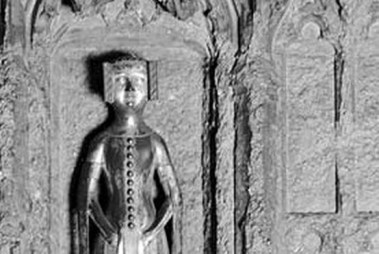 Joan of England (public domain)
Joan of England (public domain)Joan of England (c.1334-1 July 1348) Daughter of King Edward III of England and Philippa of Hainault. Joan was betrothed to Peter, the heir to Castile in 1345. Early in the summer of 1348, Joan and her retinue left England to prepare for her wedding. Joan was heavily guarded and brought many riches with her. At that time, the plague had not yet arrived in England. Joan’s ship stopped in Bordeaux, France, on the way to the wedding. Joan and her escort were said to have been warned about the plague when they arrived there, but they stayed anyway. Soon members of Joan’s entourage began to fall ill and die. In fear of her life, Joan possibly moved to a small village to escape the plague, but she succumbed to it on 1 July 1348. Her death was a big shock to her family and proved that not even royalty was safe from the plague.
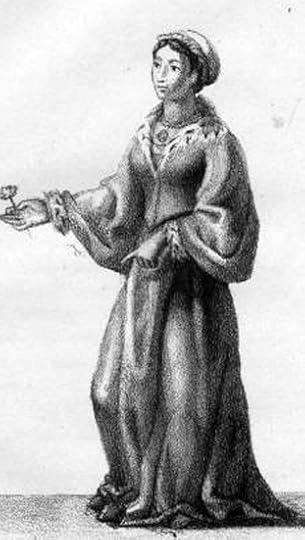 Blanche of Burgundy, Countess of Savoy (public domain)
Blanche of Burgundy, Countess of Savoy (public domain)Blanche of Burgundy, Countess of Savoy (c.1288-July 1348) Daughter of Robert II, Duke of Burgundy and Agnes of France. Sister of Joan “The Lame”, Queen of France, who also died from the plague. Blanche married Edward, Count of Savoy and they had one daughter. Given the time of Blanche’s death, the plague is a possibility.
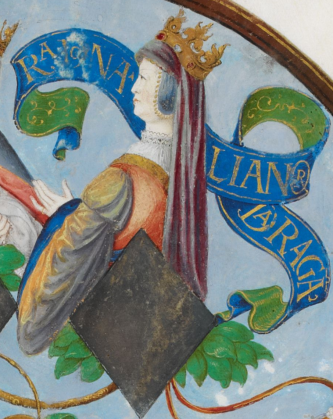 Eleanor of Portugal, Queen of Aragon (public domain)
Eleanor of Portugal, Queen of Aragon (public domain)Eleanor of Portugal, Queen of Aragon (1328-30 October 1348) Daughter of King Alfonso IV of Portugal and Beatrice of Castile. She was the second wife of King Peter IV of Aragon, whom she married in 1347. Eleanor had no children and succumbed to the plague almost a year after her wedding while travelling. Her two-year-old stepdaughter, Maria, also died of the plague the same year.
Elisabeth of Sicily, Duchess of Bavaria (1310-March 1349) Daughter of King Frederick III of Sicily and Eleanor of Anjou-Naples. She married Stephen II, Duke of Bavaria and they had four children. We could not find any sources that mention Elisabeth’s cause of death, but given the date, the plague is a strong possibility.
Margaret of Bohemia, Queen of Hungary (1335-c.7 September 1349) Daughter of Charles IV, Holy Roman Emperor and King of Bohemia and Blanche of Valois. Blanche died a year earlier, from what some thought to have been the bubonic plague, but it had not yet arrived in Prague at the time. Margaret married King Louis I of Hungary at a very young age and had no children. Margaret died during an outbreak of the plague in Hungary, probably in September 1349. Her aunt Bonne, Duchess of Normandy, also died of the plague that same month.
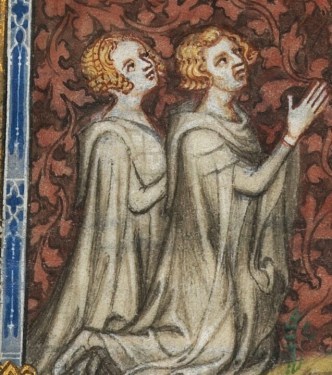 Bonne of Luxembourg, with her husband Jean (public domain)
Bonne of Luxembourg, with her husband Jean (public domain)Bonne of Bohemia, Duchess of Normandy (1315-11 September 1349) Daughter of John the Blind, King of Bohemia, and Elisabeth of Bohemia. In 1332, she married John Duke of Normandy, heir of Philip VI of France, and they had ten children. She died from the plague in September 1349, during her father-in-law’s lifetime, so she was never Queen. Her niece Margaret, Queen of Hungary also died from the plague during the same month. Bonne’s mother-in-law Joan the Lame, Queen of France also died from the plague three months later. Bonne’s husband succeeded his father as King John II of France eleven months after her death.
Margaret Wake, Countess of Kent (c.1297-19 September 1349) Daughter of John Wake, 1st Baron Wake of Liddell and Joan de Fiennes. Margaret first married John Comyn, by whom she had one short-lived son. John was killed in the Battle of Bannockburn in 1314. In 1325, she remarried to Edmund, Earl of Kent, the youngest son of King Edward I of England. By this marriage, she had three children, including Joan of Kent, later wife of Edward, the Black Prince, and mother of King Richard II of England. Edmund was executed in 1330, and Margaret never remarried. Her brother, Thomas Wake, 2nd Baron Wake of Liddell, died childless in May 1349, possibly from the plague. Margaret briefly succeeded as Baroness Wake of Liddell but succumbed to the plague a few months later.
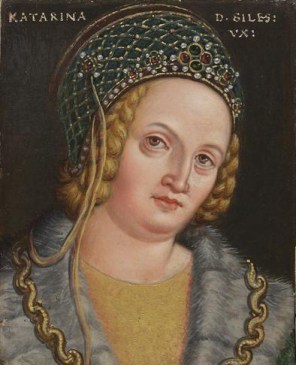 Catherine of Austria (public domain)
Catherine of Austria (public domain)Catherine of Austria, Lady of Coucy (1320-28 September 1349) Daughter of Leopold I, Duke of Austria and Catherine of Savoy. She first married Enguerrand VI, Lord of Coucy, and had one son. Enguerrand was killed in a battle of the Hundred Years War around 1346. In 1348, Catherine married for a second time to Konrad, Burgrave of Magdeburg. This marriage was short and childless. Konrad died of the plague on 25 September 1349, and Catherine followed him three days later.
Joan II, Queen of Navarre (1312-6 October 1349) Daughter of King Louis X of France and Margaret of Burgundy. She was a niece of Blanche, Countess of Savoy and Joan the Lame, Queen of France, who also both died from the plague. Joan was Queen of Navarre in her own right. In 1314, her mother was involved in the Tour de Nesle affair, imprisoned, and died the next year, possibly murdered. Because of Margaret’s adultery, there was some doubt if Louis was really her father. Louis remarried, but died in 1316, leaving his second wife, Clemence of Hungary pregnant. Five months later, she gave birth to a son, John, who was proclaimed King of France and Navarre from birth, but he only lived five days. Soon afterwards, the Salic Law was put in place, which barred female inheritance to the French throne. This law was put in place mainly because of Joan’s alleged illegitimacy. In turn, her two uncles succeeded as Kings of France and Navarre, but they also did not leave any sons. In 1318, Joan was married to her cousin, Philip of Evreux. Her last uncle died in 1328, and Joan became Queen of Navarre in her own right since that Kingdom did not use the Salic Law. Joan and her husband ruled Navarre together until Philip’s death in 1343. Together they had nine children. Joan died from the plague in France in October 1349.
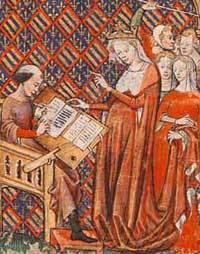 Joan of Burgundy (public domain)
Joan of Burgundy (public domain) Joan “the Lame” of Burgundy, Queen of France (c.1293-12 December 1349) Daughter of Robert II, Duke of Burgundy and Agnes of France. Her sister, Blanche, also died of the plague. Another sister, Margaret was the first wife of King Louis X of France, and mother of Queen Joan II of Navarre, who also died of the plague. Joan married Philip of Valois in 1313 and had nine children. In 1328, on the death of King Charles IV of France, the main Capetian line died out, and her husband was now the most senior member of the dynasty, and he succeeded as King Philip VI of France since the French throne could not be inherited through female lines. Joan was known as “the lame” because of a deformity, which was considered a mark of evil. Despite this, she was very politically influential and acted as regent when her husband was on campaigns during the Hundred Year’s War. Her daughter-in-law, Bonne of Bohemia died of the plague in September 1349, and Joan followed her three months later.
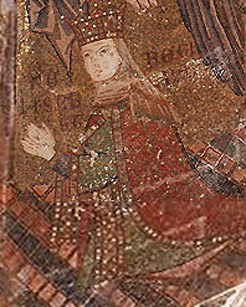 Elizabeth of Carinthia (public domain)
Elizabeth of Carinthia (public domain)Elizabeth of Carinthia, Queen of Sicily (c.1298-c.1352) Daughter of Otto III, Duke of Carinthia and Euphemia of Legnica. In 1322, she married Peter of Sicily, who became King Peter II of Sicily in 1337. Together they had nine children. Peter died in 1342, and Elizabeth, along with her brother-in-law, John were regents of Sicily for her four-year-old son, Louis. In 1348, John died from the plague, and Elizabeth became the main regent. Elizabeth died during an outbreak of plague in Sicily, in as early as 1349/50 or as late as 1352. Her oldest daughter Constance succeeded her as regent. Both Constance and Louis also died from the plague in October 1355.
The post Royal Women and the Black Death appeared first on History of Royal Women.
September 22, 2020
Rastede Castle – Home of a mysterious Princess
The town of Rastede is about 12km (7,4 miles) north of Oldenburg and houses the magnificent Castle of Rastede. It was the home of Counts and Dukes of Oldenburg and is still lived in by their descendants. It is, therefore, not open to the public. It is in a public park, so you can walk around it.
It began its life as a monastery but was transformed by Christopher, Count of Oldenburg. Anthony Günther, Count of Oldenburg, had large stables built in 1612. The former monastery was demolished in 1643 and replaced by a new hunting lodge, which was used as a summer residence. When Anthony Günther died, Oldenburg fell into Danish hands, but they did not particularly care for the area. For 40 years, it was the home of Princess Sophie Eleonore of Schleswig-Holstein-Sonderburg-Beck, daughter of August Philipp, Duke of Schleswig-Holstein-Sonderburg-Beck and his third wife Marie Sibylle of Nassau-Saarbrücken. It is unclear how she came to live there, though she did write to King Frederick IV of Denmark to thank him for allowing her to live there with a pension. Apparently, the castle was in quite a dilapidated state already, and she often asked for funds for repairs. She requested to be buried in the nearby St.-Ulrichs-Kirche, and she bequeathed 100 thalers to the church. She is now buried in the crypt of the church. Her sarcophagus was reportedly opened by Canadian soldiers looking for treasures in 1945. Sophie Eleanore had her hands folded still, and she was completely mummified.
The Erbprinzenpalais close by was lived in by Duchess Sophia Charlotte of Oldenburg after she divorced Prince Eitel Friedrich of Prussia.
Click to view slideshow.
Rastede is lovely for a day out. It has a train station with connections to Oldenburg, and the park is within walking distance of the station.
The post Rastede Castle – Home of a mysterious Princess appeared first on History of Royal Women.
September 20, 2020
Queen Elizabeth I – Queen against the odds (Part three)
One of Elizabeth’s first acts was to appoint Sir William Cecil as her Principal Secretary of State, and they would form a unique partnership over the years. On 23 November 1558, Elizabeth rode into London and moved into the Tower on 28 November. She moved again a week later, to Somerset House, before spending Christmas at the Palace of Westminster. The faithful Katherine Ashley was appointed as Mistress of the Robes, and Elizabeth also set out to select the men who would sit on her Privy council.
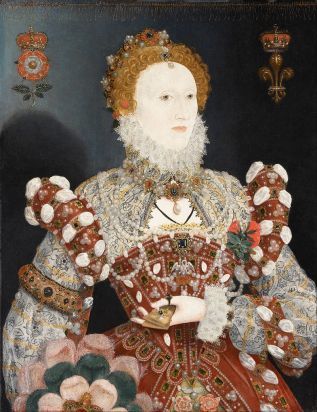 (public domain)
(public domain)On 15 January 1559, Elizabeth received a magnificent coronation at Westminster Abbey. She wore a mantle of 23 yards of gold and silver tissue with fur trimmings and was followed by her ladies-in-waiting, dressed almost as sumptuously as she was, as she processed through the city the day before. Elizabeth was crowned, first with St Edwards Crown, and then with the Imperial Crown of England, which was over seven pounds. This was then replaced with a lighter crown; possibly the one made for her mother in 1533. The coronation ring was placed on the fourth finger of her right hand. After the service was over, Elizabeth walked from Westminster Abbey to Westminster Hall with the sceptre and orb in her hand.
Elizabeth was a pragmatist when it came to dealing with religious matters. She wanted to have a Protestant solution that would not offend the Catholics too much. A new Act of Supremacy became law on 8 May 1559, and all public officials had to swear an oath of loyalty to Elizabeth as the Supreme Governor of the Church of England. A new Act of Uniformity was also passed, which made church attendance and the use of an adapted version of the 1552 Book of Common Prayer compulsory. However, the penalties attached to this were not severe.
The next major issue to deal with was Elizabeth’s future husband, as everyone expected her to marry. Count Feria, the Spanish ambassador, wrote, “The more I think about this business, the more certain I am that everything depends upon the husband this woman might take.”1 The idea that she might remain unmarried seemed inconceivable. A husband could give her an heir and could prevent a possible civil war upon her death. However, Elizabeth was quite sceptical towards marriage, and she also realised that no matter who she would pick, it would always be the wrong choice for someone. She told the Scottish ambassador that she hoped to remain single, upon which he replied, “I know the truth of that Madam, you need not tell it to me. Your Majesty thinks if you were married, you would be but Queen of England; and now you are both King and Queen.”2 Nevertheless, throughout her reign, suitors continued to be paraded before her, and she entertained them. In the end, she never married.
This did not mean, however, that she did not enjoy a flirtation or two. This did lead to some gossip at court that she had illegitimate children and that she was no longer a virgin. This seems rather improbable, if only for practical reasons. Elizabeth herself stated that “She was always surrounded by her ladies of the bedchamber and maids of honour.[…] My life is in the open, and I have so many witnesses… I cannot understand how so bad a judgment can have been formed of me.”3 Perhaps the one man she would have considered marrying was her childhood friend Robert Dudley, 1st Earl of Leicester but he was already married, and the suspicious death of his wife in 1560 cast a shadow over him.
The question of an heir remained for now, and the most senior claim was held by Mary, Queen of Scots, the granddaughter of Margaret Tudor, King Henry VIII’s elder sister and thus Elizabeth’s aunt. Mary had been Queen (consort) of France as well, but she had been widowed in 1560, and she had returned to Scotland after spending many years in France. In 1565, she remarried to Henry Stuart, Lord Darnley, a grandson of Margaret Tudor through her second marriage. He, thus, also had a significant claim to the English throne, which became reunited with Mary’s and eventually joined in their son, the future King James VI. The situation in Scotland soon spiralled out of control, during which time Henry was murdered, and Mary was forced to abdicate in favour of her young son. She eventually fled to England in 1568, expecting help from Elizabeth but Elizabeth viewed her with suspicion. The two women never met during the entire time of Mary’s imprisonment in England.
Even with Mary’s claim to Elizabeth’s throne, there were more plots against Elizabeth, which used Mary. In 1569, there was Catholic rising in the north, which intended to remove Elizabeth from the throne and replace her with Mary who would then marry Thomas Howard, 4th Duke of Norfolk. The Ridolfi plot in 1571 also intended to put Mary on the English throne and also involved Thomas Howard. He was executed for his role in the Ridolfi Plot on 2 June 1572.
Part four coming soon.
The post Queen Elizabeth I – Queen against the odds (Part three) appeared first on History of Royal Women.



